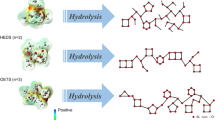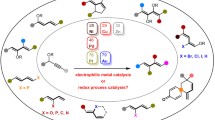Abstract
The title compound (II) was prepared by treating dry, purified α-cyclodextrin with 20 equivalents oft-butyldimethylsilyl chloride 20 hr at 110° in DMF/pyridine. Work-up of the product mixture gave 60%II, which was identified by1H and13C NMR. Treatment ofII with Bu4NF 6 hr in refluxing dry THF efficiently removed the protecting groups.
Similar content being viewed by others
Notes and References
M. L. Bender and M. Komiyama:Cyclodextrin Chemistry, Springer-Verlag (1978);
J. Szejtli:Cyclodextrins and Their Complexes, Akademiai Kiado (1982);
R. Breslow:Accts. Chem. Res. 13, 170–177 (1980);
I. Tabushi:Accts. Chem. Res. 15, 66–72 (1982).
F. Cramer and G. Mackensen:Chem. Ber. 103, 2138 (1970);
J. Szejtli, A. Liptak, I. Jodal, P. Fugedi, P. Nanasi, and A. Neszmelyi:Stärke 32, 165 (1980);
R. Bergeron, M. Meeley, and Y. Mchida:Bioorg. Chem. 5, 121 (1976);
J. Boger, D. Brenner, and J. R. Knowles:J. Am. Chem. Soc. 101, 7630 (1979);
I. Tabushi, K. Shimokawa, and K. Fujita:Tetrahedron Lett. 1527 (1976);
A. Veno and R. Breslow:Tetrahedron Lett. 3451-3454 (1982); A. P. Croft and R. A. Bartseh,Tetrahedron 39, 1417 (1983).
R. L. Wife, D. E. Read, and H. C. Volger:Proceedings of the First International Symposium on Cyclodextrins, 301–327, (Ed. J. Szejtli), Akademiai Kiado (1982).
We have observed that pyridine as a catalyst gives a higher yield ofII than does the more-frequently used imidazole.
IR: (vOH (stretch), 3440 cm−1,vSi-(CH3)3 1250 cm−1), m.p. 274°C (decomposition),1H,13C NMR: JEOL, JNM-FX270, multinuclear, CDCl3-TMS. Elemental analysis: calculated for formula: C108H228O30Si12, C-55.34, H-9.81, O-20.48, Si-14.38. Found: C-55.39, H-9.97, O-19.35, Si-14.56.
Assignments for most of the signals in the13C NMR spectra were based upon data on cyclodextrins and other carbohydrates, e.g., P. Colson, H. J. Jennings, and J. C. P. Smith:J. Am. Chem. Soc. 96, 8081 (1974); K. Takeo, K. Hirose, and T. Kluge:Chem. Lett. 1233 (1973); J. Boger, R. Corcoran, and J.-M. Lehn:Helv. Chim. Acta 61, 2190 (1978).
13C NMR Spectroscopy, Verlag-Chemie pp. 223–242, 1975. See also J. Bogeret al. [2] and R. L. Wifeet al. [3].
E. J. Corey and L. Vankateswarlu:J. Am. Chem. Soc. 94, 6190 (1972).
Author information
Authors and Affiliations
Rights and permissions
About this article
Cite this article
Michalski, T.J., Kendler, A. & Bender, M.L. A silyl-α-cyclodextrin intermediate. Preparation and characterization of dodeca-t-butyldimethylsilyl-hexahydroxy-α-cyclodextrin. Journal of Inclusion Phenomena 1, 125–128 (1983). https://doi.org/10.1007/BF00656814
Received:
Issue Date:
DOI: https://doi.org/10.1007/BF00656814




